The subject can expand and multiply in to many different types; 3D textiles, beads etc etc. For this course however, I want to experiment with making backgrounds and layers on which I can stitch or leave:
This technique works by using plastic and melt-able materials; which are trapped with a layer of bondaweb and then ironed to make all the parts merge together……
1. Have a look through your materials, and begin to make a little ‘scene’ from them. This could be anything, even a sunset! You can snip and cut bits to create a personal piece.
2. You could use a larger piece of material as a “backing” and then build your “scene” on this.
3. Once you are happy, lie a piece of bondaweb other the whole design.
4. Trap this inside some greaseproof paper, and then carefully iron over.
5. Leave to cool for a few seconds, and gently peel back to see if all the bondaweb has melted.
6. If it seems to need more bondaweb to hold your design in place; cut another piece of bondaweb and lie it over again. Then repeat the ironing process.
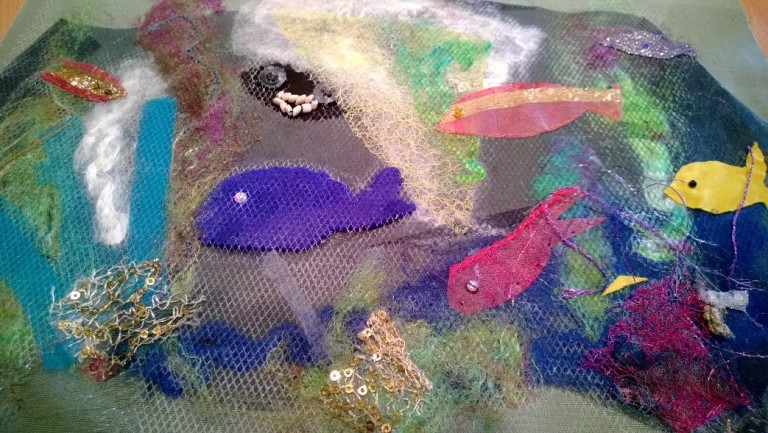
Once finished, you should end up with a flat piece of bondaweb sandwiched fabric, which you can then use to stitch etc.
Using this technique, I wondered what would happen if I tried to “paint collage” using my drawings as a guide. Chopping fabrics and arranging them on the bondaweb, before ironing more bondaweb on top? It could act as a base to stitch on to, cut up etc etc.
So, looking again to my isolated shapes and drawings, from the full original drawings, I began to piece together my work…..
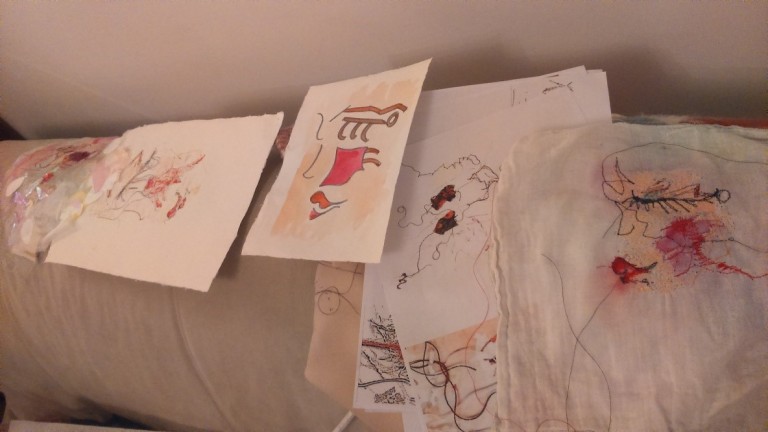
As you can see, my ironing board where I would need to be working, became littered with all my fabric possibilities and metallic pieces, such as ribbons. This type of work is so much fun, cupboards are emptied just to see what can be used to melt with….packets, sweet wrappers etc. Yet I had never thought about using it in this way.
Now I have made about four pieces, including a few sample bits. I realise I will not be able to develop this massively at this stage, yet these samples will give me an idea to see if it works with my ideas.

I have deliberately made some subtle, by putting my collage together, then overlaying my beautiful hand dyed silk as a complete layer to mute my colour palette. That’s what has happened in the one above. I intend to pick bits out of this with my machine, to highlight basic facial features. I will use the colours seen in the collage to influence my thread choice.
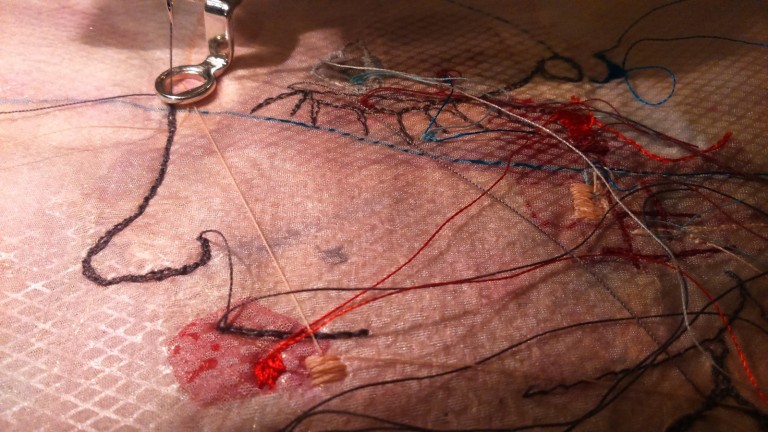
I am really enthusiastic about this technique. It seems that I have come across a new way to illustrate in a fine art textiles way. A new way to paint and incorporate figurative value too.
The hard part about this exercise, is knowing how much stitching to do.
Of course I could add other types of embellishment and other types of hand stitching as well as machine. Yes I do want to play with more techniques not just this within this assignment.
Another idea I came up with, was incorporating Pleating within this idea. I used out of my pieces and used the still hot bondaweb to create creases….

I could do all sorts with this idea, form cheekbones, neck lines, frown lines, or 3D pieces. I could even make a 3D head if so inclined!
I am really happy with my results as shown below:
I chose to make one larger piece, which is this one. Added machine stitching:
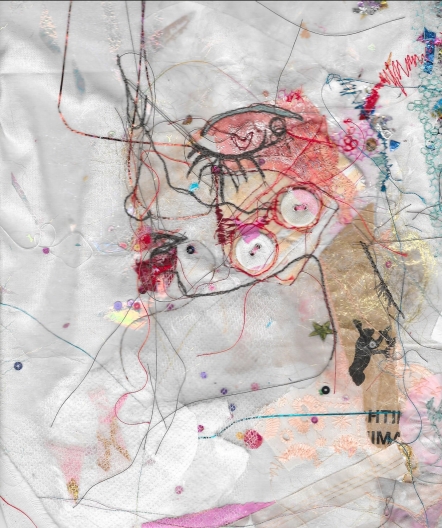
Notice the use of an old shirt of mine with the button detail on the cheek area and old brown paper packets. In other words, a real mix of materials. Some are plastic in order to melt, while it doesn’t all have to be, as sometimes the texture of papers is nice too, as seen.
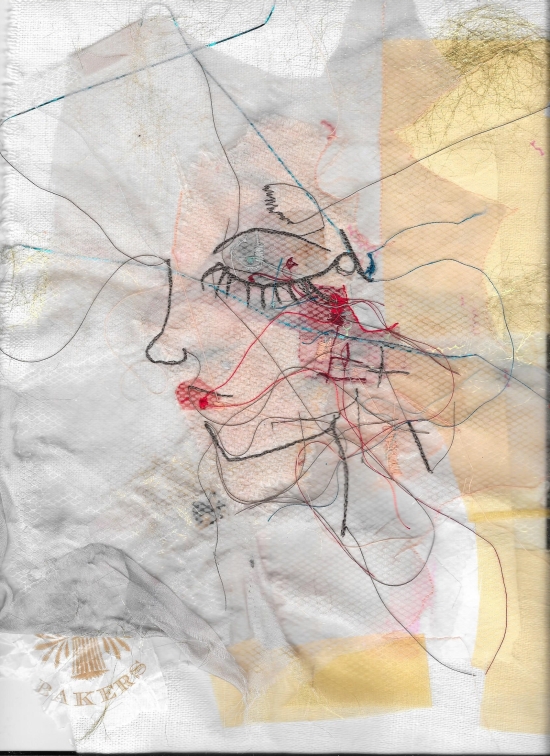
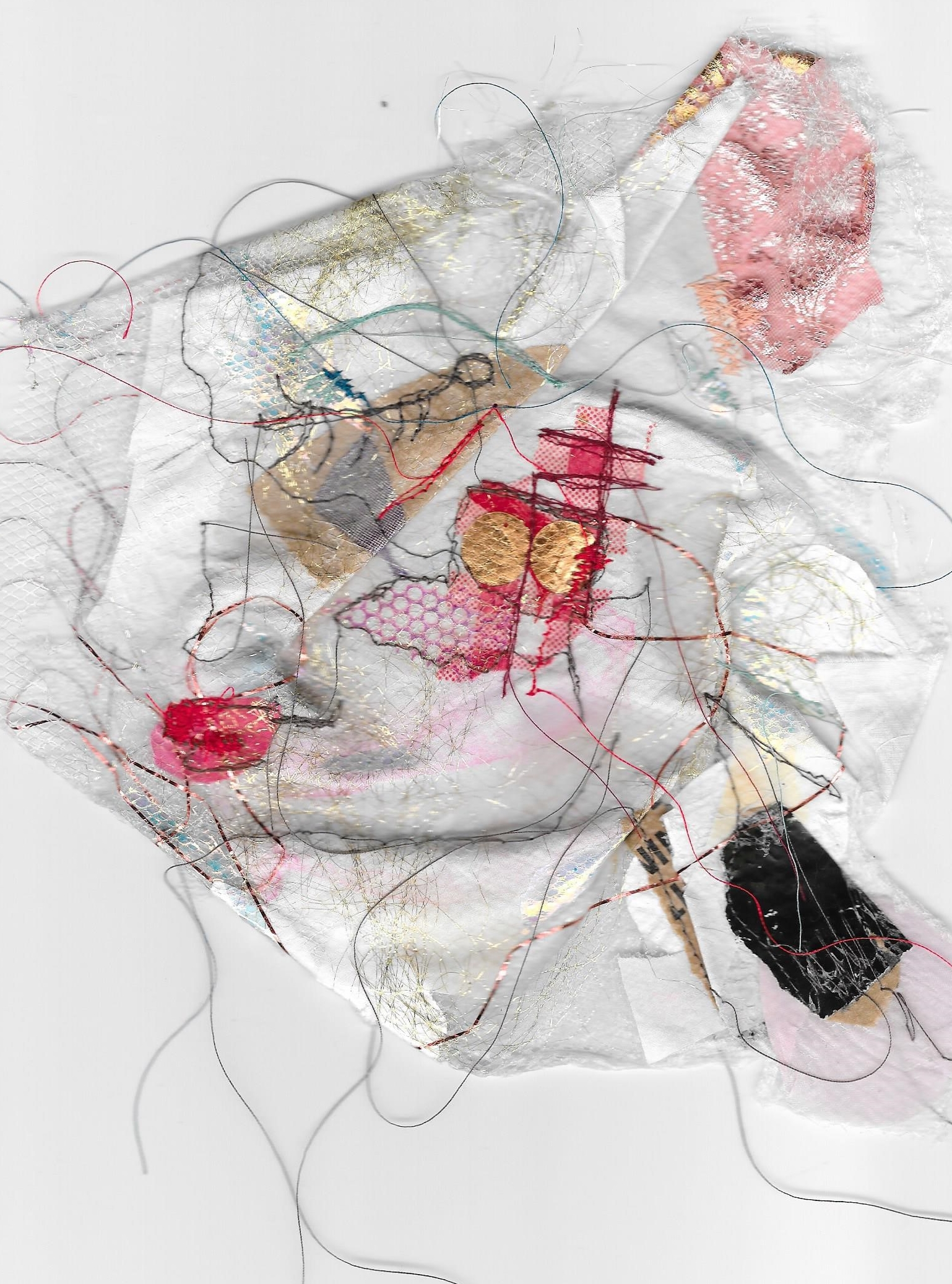
This was my pleated trial. Notice the cheek and neckline. It makes me laugh, as there are so many possibilities. I left my trademark threads dangling again, thus although all my experiments are different, they still hold a piece of who I am. Notice that in some cases, such as the checked cheek fabric, I have gone with the lines in my stitch lines, to highlight the fabric. Colours were carefully chosen, this was no accident, yet still really a play.
Summing up this experiment:
This was a risk, as although I have played with heat distressing fabrics in the past, I never extended it or manipulated it. I realise that in this section, it is about the number of techniques, rather than the extension of one or two. Thus I feel a tad frustrated, as I do just want to continue with this! However I feel that I have trailed it enough to have produced evidence of creativity and possibility in this regard.
Notice the combination of techniques here – I have merged bonded surfaces with machine embroidery and fabric manipulation in the form of pleating.
I have now scanned my samples into my PC, so that I can edit or play with them to see if they could be worked into digital prints in the future. I may wait to trial this until the next project.
One artist that this technique reminded me of was Louise Baldwin:
She stood out to myself, because of the way she uses strongly coloured backgrounds and draws in stitch basic facial outlines on top. Here are a few examples:
This is what she tells us about her practice: ‘My current work is a combination of collaged mundane domestic packaging, layers of stitched imagery and pom poms. There is a confusion of colour, incidental imagery, doorknobs, handles and a clash of materials as they are brought together within a frame that excites me. I work directly with the materials, not planning beforehand but responding as the work develops, building up layers of imagery. Pieces are cut down and added to, turned upside down, stitched and reorganised until they seem right.
Like life they need to have a touch of melancholy mixed in with the pleasure. I am interested in how we absorb knowledge and experiences, selecting out the bits that resonate for us, sometimes carefully, other times by accident, it’s what makes us who we are. In this work, connections are made between the most seemingly random things, cell structures and patchwork, cereal boxes and simple sums. They are like bits of information, memories and desires that float around our brains waiting to surface.’
That’s what I personally like about her work, how it connects a diary or life element, with seemingly mixed up work elements, as she admits above. She favours recycled materials, thus again is clever with what she uses as her resources. She Uses a variety of recycled papers and packaging and fabric scraps to create decorative collages. The collages are compacted with machine stitch before being lovingly hand stitched with shapes constructed from simple back-stitch. Louise uses images from her childhood in her work in the form of her simple line ‘drawings’ created with hand stitch. This provides an ideal inspiration source for anyone wanting to include subtle childhood references within their work to create a deeper meaning behind the surface decoration.




